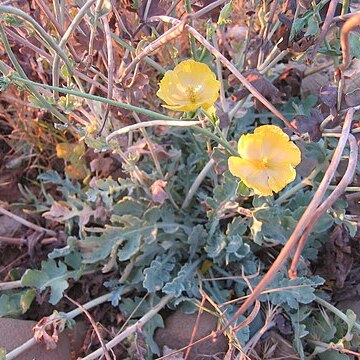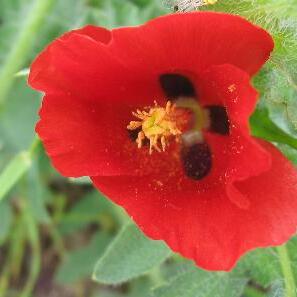Annual, biennial or perennial, caulescent, sometimes (not in Australia) sub-shrubby herbs from taproots, glaucous; sap yellow. Stems leafy, branching. Leaves: basal leaves rosulate, petiolate; cauline leaves alternate, sessile; lamina pinnately lobed or (not in Australia) unlobed, dentate or sometimes (not in Australia) sinuate or entire, not harshly prickly. Flowers solitary, axillary or terminal, without hypanthium. Sepals 2, distinct. Petals 4. Filaments yellow. Ovary 2-locular; style absent or indistinct; stigma 2-lobed, not on a disc. Capsule erect, sublinear, 2-locular, 2-valved, dehiscing from the apex or (not in Australia) the base. Seeds many, reticulate-pitted, dark brown, embedded in a pithy septum; aril absent.
Herbs , annual, biennial, or perennial, caulescent, glaucous, from taproots; sap yellow. Stems leafy, sometimes becoming woody at base. Leaves: basal rosulate, petiolate; cauline alternate, sessile; blades 1-2× pinnately lobed [unlobed]. Inflorescences axillary or terminal, 1-flowered; bracts present. Flowers: sepals 2, distinct; petals 4; stamens many; pistil 2-carpellate; ovary 2-locular; style absent or indistinct; stigma 2-lobed. Capsules erect, 2-valved, dehiscing from apex [base]. Seeds many, dark brown, reticulate-pitted, embedded in pithy septum, aril absent. x = 6.
Annual, biennial or perennial herbs with yellow to orange latex. Lvs lobed to 1-2-pinnatifid, usually hispid, glaucous. Fls solitary or in lax leafy cymes. Sepals 2, entire, free, falling as fl. opens, not horned. Petals 4, crumpled in bud, yellow to red. Stigma 2-lobed; style very short or 0. Placentae corky, joined in the centre of the ovary to form a septum. Capsules linear, 2-celled, dehiscing by 2 valves. Seeds reniform, without aril.
Sep 2; pet 4, yellow; ovary cylindric, bilocular; stigmas sessile, 2-lobed; fr elongate, usually curved, bilocular, dehiscent from the top downward by elongate valves; herbs with saffron-colored juice, large, pinnately lobed lvs, and large, yellow fls terminating the branches or on leafy-bracted axillary peduncles. 20, Eurasia.


